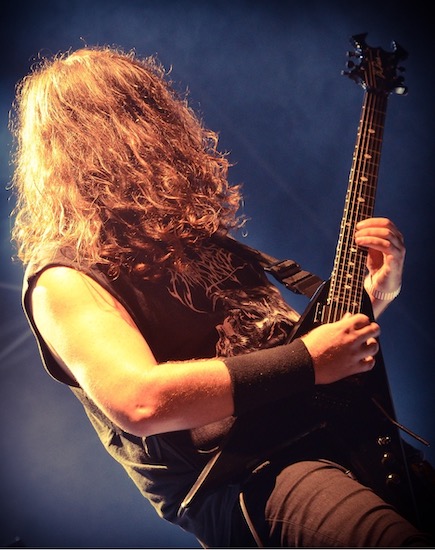
(NCS contributor Nathan Ferreira prepared the following exhaustive retrospective concerning the work of Turkish musician Mustafa Gürcalioğlu (a current or former member of such bands as Decaying Purity, Burial Invocation, Engulfed, Diabolizer, and Hyperdontia), which includes extensive discussions with the artist.)
I’m back with another way-too-ambitious deep-dive project, inspired by my excursions into The Ruins of Beverast’s body of work earlier this year. I was hoping to get this out in time for the premieres of either or Hyperdontia, but alas, that proved to be too lofty a goal. I may have bit off more than I could chew. Either way, it’s finally ready for all your music nerd-related pleasures, just in time for you to add those two bands to your year-end lists – if they’re not on there already.
The discography of Mustafa Gürcalioğlu was one that I wanted to give in-depth coverage to for a few reasons. One, it’s incredibly consistent – I don’t think the guy’s put out a stinker yet, and even the ones you don’t think you like tend to grow on you over time. Two, it starts out good, slowly gets better, and it sounds like the best is yet to come, since the most recent albums by all four of his projects are the strongest. Three, there are enough small differences between albums and different bands that you can tell them apart, but because of the aforementioned consistency, you’re still guaranteed a solid listen while also getting something new along the way. No one has given his discography the appreciation it deserves – if you didn’t get the hint yet, pound for pound it’s one of the best in metal.
Since Mustafa is a more accessible and/or approachable character than Alexander von Meilenwald proved to be, I was able to flag him down and ask him a ton of questions, so with each venture into one of his bands, I’ve included some information straight from the creator’s mouth (keyboard?) to add extra context and colour. In addition, I’ll kick off the article with some more general questions so you can get to know the man behind the music a bit more before fully taking the plunge. Enjoy!
—
Why do you like making music? What/who are some of the bands/musicians that made you want to pick up a guitar and start playing yourself?
I guess this is because I internalized “South of Heaven”, the first album I bought when I was a middle school kid in 1997. I think it’s the album I’ve listened to the most in my life, and every time it plays, I still listen to that album with the same hunger as the first day. The sound, the riffs, the arrangements etc., everyone has a “Reign in Blood” in their life, but my “Reign in Blood” is definitely “South of Heaven” 🙂
When I started listening to this album at that time, as much as I enjoyed listening, the desire to try to play it and similar materials fueled me to play guitar even though I didn’t have the slightest idea how to do it. Making music, writing, producing is the most important thing I enjoy doing in life, and I will continue as long as my hands can hold the guitar and my ears can hear.
Tell me more about Mictian – they appear to be the earliest band you were a part of, but the other members are none of the people you work with in your current projects. Was this your introduction into the metal scene? What became of them?
It would be absolutely correct to say that it was that band that entered the metal scene, yes. It was a Black Metal band that I played in mainly between 2003-2004. In fact, towards the end, I took on the guitar/vocals. The style that I wanted to direct towards the last period of that band was actually very close to the Diabolizer you are listening to today. In fact, some Diabolizer tracks released contain riffs that I wrote back then. We disbanded towards the end of 2004. It was an enjoyable and beneficial time.
Your playing style seems to shine through regardless of the style or band you’re in. For each of your four projects, who is the primary songwriter?
For Decaying Purity, myself and our drummer Onur write the songs together. Some of the songs are all mine, some are his, and some we composed together. There were some riffs written by Serkan and Malik in the previous albums. Onur is also a very good guitarist; I can say that he is a virtuoso level solo guitarist unfortunately [laughs]. All the Diabolizer music belongs to me. Also in Engulfed, there were very good riffs written by Serkan and he wrote 1,2 songs in the first album.. Hyperdontia’s latest album has some good riffs written by Malik. In all the bands, apart from the full songs I write, I take on all of these ideas in the end, evaluate them, make arrangements to give them their final form, and they become what you listen to.
How do you divide your time between projects? Your schedule must be filled to the brim. Do you spend more time working on stuff for some bands than others?
I try to allocate equal time to all of them, but the business of band schedules does change periodically and I may need to spare more time to some of them during those periods. Sometimes the schedules can overlap, but I manage to adjust. I don’t know how either. Sometimes you are able to move forward more easily when you are not tied to a calendar and planning. I guess that’s why things move smoothly for me.
What is your advice for a novice guitarist who wants to be as good as you someday?
This is going to be such a cliché, but first of all, do you really love what you are doing? Is this passion something like a hereditary disease in you, or are you just doing it for the sake of it? I think it is necessary to consider this, evaluate it objectively, then set out your path. If you are really passionate, you start to equip yourself in the way and direction in which you want to progress, both technically and in terms of vision. Then you don’t need anyone to advise you.
You have a lot of member overlaps between your musical projects. Malik Çamlica plays in three of your bands, Aberrant plays in two, Serkan Niron is in two, there’s even more if you count Burial Invocation. Yet, despite this, I find each band has their own unique flavour. How do you make sure all your projects don’t just sound the same?
All my bands play Death Metal, but as you know, they each have a different death metal style. There are bound to be some coinciding ideas. However, with my friends you mentioned, we only turn the materials we enjoy listening to and playing, into songs. If we end up with a result that is really pleasing to us in the end, we don’t worry too much about the rest, whether it’s similar to this or that, etc.
How do you go about finding the right fit for a record label? Do you reach out to them, or are you sought-after enough that they contact you now?
This actually depends on the band. If you are a new band, you push to get into the radar of the labels. As you start to gain a place in the scene and if you are putting out a record that can leave a mark, you finally get in touch with the right people. Some labels often have a certain style in the bands they work with, while some have wider frames and release many different styles. So far, I have tried to cooperate with the people who are most suitable for the line of the products I have made, and fortunately, things have progressed very positively in this regard.
The photo below is of your rig setup. Break it down for the nerds reading this. I see an ENGL and a Marshall, as well as a BC Rich, Jackson and Ibanez guitars. Do you use different guitars/effects/pedals depending on the project?
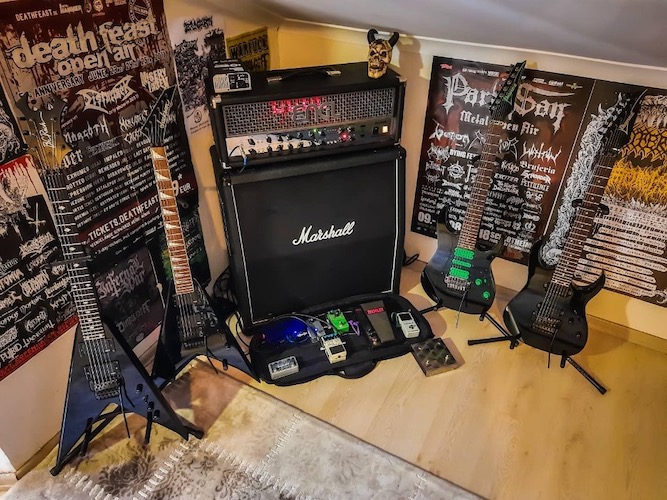
This photo is my latest updated equipment. In the past, I have used many others for recordings. Guitars may vary depending on the band I am playing with, but I enjoy using all of them with every band, so whichever band I am going to play with I use the appropriate string gauge, adjust the tuning accordingly. Amp, pedal etc. preference also varies according to the sound I want to reflect on the material I record.
Do you handle live booking for any of your bands or how do you go about booking shows/tours?
People who want to include us in their events contact us through social media or e-mail. We evaluate every offer that makes sense to us and that has appropriate dates and we try to take part.
I notice you’ve started playing live again, with some select local appearances by Diabolizer in particular. Any tours in the works you want to hint at here? Any chance you’ll come to North America any time soon? (pretty please)
Yes, live shows have started again as conditions slightly approved and life became more livable with adaptations all over the world. So far we played 2 shows with Diabolizer in August and November. There are no tours or shows abroad planned for Diabolizer yet. There are some ideas in talks, and we would definitely consider them if they turn into actualized offers. We hope to come to North America with Diabolizer one day, there is a lot of demand for it.
What are some of your favourite shows/festivals/tours you’ve played? Favorite band(s) you’ve toured/gigged with?
The open-air show we played with Diabolizer in August this year was very good. It appeased our hunger after the long quarantine. I can say that this was my favorite event with Diabolizer. I was part of many enjoyable events with great bands and friends over the years, it’s a bit difficult to choose the best one.
What are some other bands from your local scene I should check out? Gore Dimension put out a great album this year, but aside from that and your stuff I don’t know too much else about the region. Who are some of the biggest influencers of the Turkish scene?
I think it would not be too pretentious to say that Death metal is Turkish metal scene’s best metal export abroad. In fact, I think Death Metal is the only good thing going right in this country right now 🙂 There are many good bands that have made a name for themselves in the international scene. In other words, even though they have not had much influence on the music I’ve made so far, bands such as Suicide and Cenotaph are very important names for Death Metal in this country. Cenotaph’s “Puked Genital Purulency“ especially has become a cult favorite and in my opinion it is the foundation that fired up the Turkish extreme metal scene. Apart from these cult names, Decimation, Burial Invocation, Carnophage, Molested Divinity, Archaic Vanity, Hellsodomy are some of the names I would recommend you to check out.
What have you been listening to lately? Hit me with all your obscure death metal recs.
I think Cambion’s “Conflagrate the Celestial Refugium” was the new release I consumed the most this year. It is such a diabolic death metal attack in a style I really like. Apart from that, I listen to the new singles released by Concrete Winds, Malefic Throne and Texan brutal death metal band Stabbing from time to time, and I look forward to their albums. I also routinely consume a lot of death/thrash albums that have become the soundtracks of my daily life and can be considered cult for me.
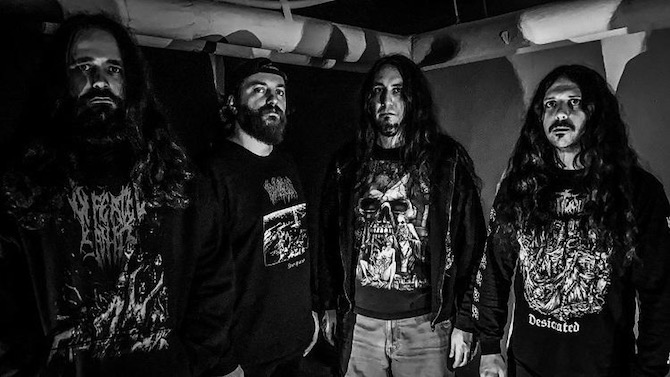
DECAYING PURITY
The OG Mustafa project, or at least the first thing he was in that got off the ground over 15 years ago, which is evident because they have by far the largest following (according to Facebook anyway). As it’s the longest-running of the groups I’ll be diving into, it’s also got the thickest back catalog, with four full-length albums (and a demo, but all the tracks from it appeared on the debut anyways) that detail a subtle, gradual evolution. One of the notable distinguishing traits of Decaying Purity is that they take more modern brutal death metal influences, whereas Mustafa’s other forms pay more tribute to their old-school death metal roots and infuse that with the modern sound. OSDM inspiration is never completely absent from this man’s music, but it’s the least pronounced here.
You can hear the prototypes of all the later projects in spurts. Think of Decaying Purity as the main skeleton and everything else as a Hydra-head-like extension. Their riffing palate is versatile, with subtle hat tips to black, thrash and old-school death metal used to garnish the thick and hearty brutal death base to keep you at attention over the course of multiple songs.
It did take about a decade for the subtle flourishes to define themselves amidst the cacophony. Their debut, Phases of Infinite Torture, came out right in the eye of the mid-00s tech/brutal death metal storm, back when it was a wide open landscape for every skilled riffcrafter and hyperspeed drummer to push their music to the absolute limits of complexity, inaccessibility and, of course, brutality. Their debut is right at home in that scene, with a consistent, sinister sense of groove that could be compared to Deeds of Flesh, Inveracity, Malignancy, and the almighty Suffocation’s intricate bludgeoning.
Right from their inception, Decaying Purity was never about bringing a new approach to the extreme music that was coming out at the time. Their focus lies more in refining the elements that were already present, fiddling with the knobs on their amps until the thick riffs cut into your gut like it’s butter. This is where Mustafa started to carve out his signature, mid-heavy guitar tone that is a cornerstone of the riffs’ piercing resonance.
Though the Turkish group was still establishing their identity in 2008, you can already tell they’d mastered treading the fine line between brutality and groove. Most bands will veer heavily towards one side of the pendulum: either they exclusively focus on the technical side, or they slam and slam and slam until you think they can’t anymore and then they drop an even bigger slam. Very few bands have found the sweet spot in the middle ground, and in my opinion it’s the masterful riffwork by Mustafa that allows Decaying Purity to get to it. The faster guitars with lots of little fretboard licks never add complexities in excess, and the tempo drops – i.e. what you could call the “breakdowns” – have a certain depth to their melody, always staying active enough to keep the song rolling forward while still understanding their primary assignment of being skull-fuckingly brutal.
Where the debut establishes the sickly heaviness of their sound, the sophomore refines the formula with an enhanced production job, perhaps the mark of producer Ünsal Özata, who teamed up with the band starting from The Existence of Infinite Agony, and has mixed and mastered all of their work since. His heavy yet well-rounded job magnifies the intensity, propelling this towards being the most straightforward and direct of Decaying Purity’s work. Defeated Sanity’s snaking complexity is mixed with the bludgeoning speed of Putridity, creating songs that build tension through cavalcades of blast beats and thick, brute force in the melody.
The punctuation marks are the nasty slams that pop in where you least expect them – sometimes near the beginning, sometimes it’s suddenly midway through, but the band does a great job obfuscating where they’re going to be, which gives them an element of surprise each time they beat your brain into a bloody pulp. It’s the structuring intricacies and smart, subtle shifts between sections that gives the songs a depth and staying power, on top of just being fun to listen to for any brutal death metal fan.
As this group got tighter and more in sync with each other’s ideas, they recognized that things could only get so brutal before they turned into an Encenathrakh-esque heavy wall. That understanding is conveyed in Malignant Resurrection of the Fallen Souls, which colors the music in a fashion cleverly similar to the metamorphosing album cover. There’s obviously still no shortage of aggression, but the guitars venture up the fretboard more often. The rhythms keep a steady pace through the dips and surges, letting the harmonies and interplay between the guitars and bass sink in.
The progression won’t be something you can identify the first time you hear a given album – this is still brutal death metal and there’s only so much you can change the qualities of the style without venturing into a new subgenre. However, when you’ve spent several months slowly digesting a dozen albums by the same guitarist like I have, the steps that Decaying Purity took to enhance and evolve their music are very audible on this one.
Their fourth album, Mass Extinction of the Providential Ones, is what a band with the same lineup for 14 years should sound like. It’s clinically tight and crisp, with a clarity in the production that lets you feel every note. Yet, even with that, there’s still an organic warmth to the heaviness of it, and it sustains itself at faster tempos pretty consistently, with tremendous detail and care put into each section. The band’s natural chemistry and synchronicity makes it so they barely need to write transitions. The riffs are so good they can get away with just stapling parts together in riff slideshows. Instead of a traditional rise and fall, a song will cruise along in a linear fashion with twenty parts that make you go “damn that was sick”. Then, the next song does the same thing…and again, seven more times until the album’s done.
With a trio of full-lengths behind this, and showing steady improvement with each new one, it would have been tough to figure out how to improve further on a fourth album. Yet, against the odds, it continues the upward trend and is the strongest of the Decaying Purity releases. The riffs know what they want to be now, incorporating that slightly melodic undercurrent that Malignant Resurrection has into the heftiest guitar tone this band has had. I’m going to be raving a lot about the wonderfully savoury mids in Mustafa’s music, and short of Diabolizer’s full-length debut, Mass Extinction of the Providential Ones has the beefiest production job. The cymbal noise and reverb is cleaned up, and all that remains is a treasure trove of tasty licks.
You recently shared this photo with drummer Onur Gazioğlu (below, left). Tell us more about where/when this was. Was this the beginning of Decaying Purity?
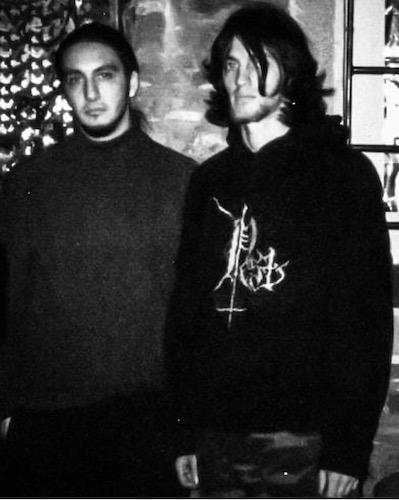
The photo is from 2004. Onur was playing in an old band called “Core” at that time. They were a death/thrash/crossover band. I met Onur at the rehearsal studio we both went to back then. One day, they told me they had a concert in Bursa and they could not reach their guitarist, and the show was in 3-4 days. I had listened to their recordings before and said I could help them out. We rehearsed in the remaining days and went to the show together; this photo is from that day. Then I was in that group for a short period of time. We later both left that band and gave life to Decaying Purity.
Would you consider Decaying Purity your “main” band? It is the longest tenured and has the biggest following (according to Facebook, anyway) of your 4 projects.
I definitely agree. Even though it has not been as active as my other bands in recent years, Decaying Purity is my main band and it will always be so even if it vanishes one day.
The most important thing that brought me to the level I am today in musical terms is Decaying Purity and I enjoy both playing and listening to its music like a fan.
What bands are the main influences for Decaying Purity? Musical or otherwise.
I can say that Decaying Purity was inspired by mid-period American Death Metal bands and early 2000’s American / European brutal death. I mean, we’ve consumed a lot of valuable death metal albums from our teenage years ’til now. Rather than mentioning specific names, I can say that they are all sources of inspiration in some way.
How have those influences changed over time? I hear a lot of Deeds of Flesh and early Defeated Sanity on the first couple albums, but later on it seems like there’s a wider range of stuff at play.
These influences somehow take effect the moment we start to write music. There is no clear, tangible definition. Even if there was a formula, I don’t think it’s appropriate to formulate these situations. We just start writing, and whatever comes out of our hands, what we enjoy in the moment becomes Decaying Purity‘s music.
Decaying Purity is allegedly a part of the TRDM movement. Tell me more about this. What is it? Who else is involved in it? I only know of DP and Cenotaph.
There really isn’t much to talk about. I can only say that it is a community consisting of some death metal bands residing in Turkey and I mentioned a few names in one of my previous answers.
The band has kept a consistent lineup, with one exception: on Malignant Resurrection of the Fallen Souls, you provided bass lines in replacement of Malik Çamlica. What caused Malik to depart and re-join one album later?
Malik moved to Copenhagen at that time and wasn’t able to devote enough time to the band so he had to leave. After his life settled down he joined the band again, that’s all.
Looking back, do you have a favorite Decaying Purity album? A least favorite?
I love all of them, they were all enjoyable albums for me. But “Phases of Dimensional Torture” will always have a special place as it was my first album.
Is there anything you would have changed about the writing and recording process of any of the band’s four albums?
They are all special to us as they are now, and they should stay that way.
Decaying Purity has worked with Sevared Records for three albums and over 10 years. Tell us more about how you landed on Sevared as the label of choice to support DP.
We signed with Sevared Records for the re-release of our first album in 2010 and then they wanted to work with us for the second album. We’ve been together ever since. They’ve always provided what we ask from them and have done a great job in distributing our albums all over the world.
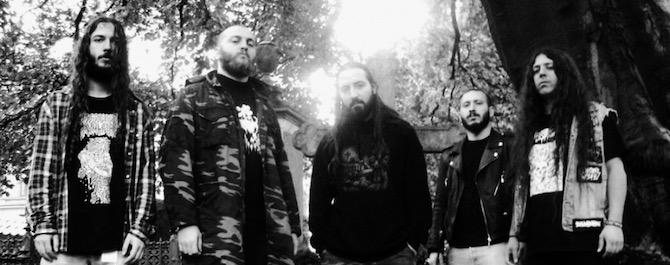
BURIAL INVOCATION – RITUALS OF THE GROTESQUE
Bet you didn’t know Mustafa had a stint with these guys! They’ve slowly emerged as one of the bigger players in Turkish death metal, but ten years ago they were one of the upstart bands on a newly formed label at the time, the now-ubiquitous Dark Descent Records. This quick little EP was the fourth release ever done by the label (and I’m proud to say I own an original press copy of this on CD). This is the apparent beginning of a long and fruitful partnership between Mustafa’s projects and Dark Descent that has lasted over a decade and continues to this day.
The later work of Burial Invocation evolved into more ominous and long-form atmospheres, however, Rituals of the Grotesque, the only release Mustafa is involved with, is a more straightforward affair. There’s a lingering HM-2 influence in the tone, and clocking in at under 20 minutes through four songs, no time is wasted. Hints of murky, modern atmospheres a la Dead Congregation creep into the simpler, Bolt Thrower-esque guitars, and the crunchy, trebly production gives some bite. It might not blow your mind, but it’s a fun little EP. One could even consider this a precursor of sorts to Engulfed, as half of Burial Invocation (drummer Aberrant and guitarist Can Darbaz) makes up their core.
PS: Guess who the only other member of Engulfed is? Decaying Purity vocalist Serkan Niron. This Turkish scene gets incestuous.
You briefly played in Burial Invocation from 2009 – 2011, contributing guitars to the Ritual of the Grotesque EP. Tell me more about your reasons for joining this band.
Burial Invocation was the project of former Cenotaph guitarist Cihan. Aberrant was the first to join the band before me, and then they asked me if I wanted to be a part of it, and once I listened to the songs, I liked it and accepted immediately. I only played the guitar in their first EP of the band; I didn’t write a single riff for this band because Cihan had already given very good materials to us. It was a period I really enjoyed playing.
What was your reason for leaving Burial Invocation?
We live in different cities, Cihan is in Ankara and I am in Istanbul. At that time, he wanted to work with a guitarist who could be closer to him in the same city, with whom he could work more comfortably, that’s all. Of course, there is nothing negative, we are all still friends and see each other.
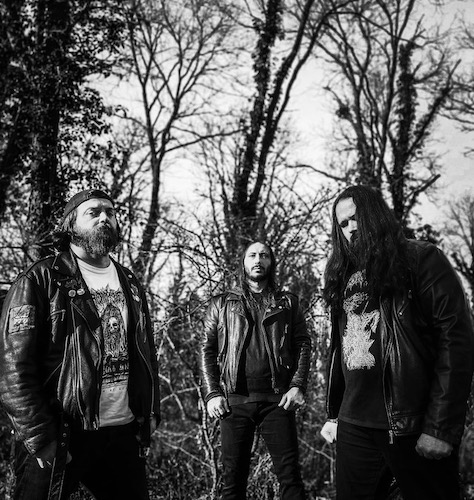
ENGULFED
This is the most melodic of the Mustafa projects… sorta. Even though this has a more immediate accessibility to it than Decaying Purity and Hyperdontia, the guitars retain the thick, snaking style and never descend into outright HM-2 worship or shameless aping of Dismember. The first album, Engulfed in Obscurity, does underscore the buzzsaw tone and has some more frequent hat-tips to ’90s Swedeath, while the follow-up EP plays with some lower, more spacious tones, but nonetheless this might be Mustafa’s most infectious stuff, and given the number of earworm riffs in his back catalog – as I hope you can tell by now – that’s saying something.
Because Engulfed uses just a tad less of Mustafa’s immediately recognizable style in favor of old-school tributes, the intricate yet natural flow of the songs is underscored. In other words, because this sounds more like Carnage, you realize that the songwriting is crafted with more time and care than a typical album in that style. Songs never use familiar tropes of repeating verse or chorus riffs, although they do occasionally bring back certain parts multiple times to maintain a theme, but they never return in places that feel predictable. There’s only so many different ways you can play this sort of death metal, so the key in making it stick is making sure the arrangements and progressions are distinct and keep you interested. Engulfed in Obscurity is like Incantation if they had hooks, if that makes any sense at all. Whatever it is, it works.
Despite their quality, I will admit Engulfed is the band I’m the least familiar with of the “Big Mustafa Four”, but that’s not due to lack of quality. If anything, I see the Vengeance of the Fallen EP as some of Gürcalioğlu’s most well-rounded and detailed work to date. Where the debut album was a bit more rooted in older traditions and the unique structures only occasionally poked through, Vengeance of the Fallen fuses uptempo, pulverizing death metal with dense, ominous atmosphere in a rare niche similar to Dead Congregation, one of very few bands that can truly be considered in the same sonic ballpark. The precise mix of being not quite old-school, not quite modern, and having doom influences without it feeling slow, isn’t a balance that bands strike often, but Mustafa is nothing if not consistent in terms of delivering the quality goods.
Vengeance of the Fallen gives his guitars a chance to play with a wider range of ideas, integrating the higher-pitched tremolo melody into a dense, harrowing storm that maintains a certain unpredictability – you can never tell where they’re going to go next, but you can’t wait to hear it. If they continue down this path on their next full-length – which they almost certainly will – this will be my favorite of a very high-quality group of bands.
Engulfed recruited Can Darbaz this year, who also plays with you in Diabolizer. Is he meant to be mostly a live guitarist, or will he be making songwriting contributions in the future as well?
Yes, I play with Can in Diabolizer – we already have a very good live harmony. Since we needed a second guitarist for Engulfed, we included him in the lineup. He is our full time member now, not just a session guitarist.
You used art from the legendary Timo Ketola (RIP) for the band’s most recent EP. Was this a commissioned piece? How did you get connected? Tell me more about your experiences working with him.
We have admired Timo’s art for years. When we started recording the new Engulfed EP, he was the first name that came to our mind for the cover art and we contacted him, explained the ideas and the concept we had in mind. He was very involved, paid attention to details and was very harmonious, it was a pleasure to work with him. When we received the final version of the cover, I can say that we were truly hyped because it was an amazing piece, he presented us exactly what we had envisioned. And unfortunately, shortly after our painting was completed, we found out that we lost him due to health issues. He had such a vivacious, friendly style. His immense artistic contribution to the world will always be remembered.
I see Engulfed as the most melodic group in your artistic oeuvre. Would you agree? Are the influences and inspirations for Engulfed different than they are in your other projects? If so, how?
Engulfed focuses on the darker side of death metal pouring out of our minds. It’s true that it has a slightly more melodic riff flow, but this more ominous melody flow is what sets it apart from my other bands.
Even though Engulfed just put out an EP in 2020, that already seems like forever ago with COVID. What are your future plans and aspirations for this project?
The release of this EP was delayed because of the damn covid. In fact, if it weren’t for this pandemic, the release was going to coincide with our European tour with Blood Incantation in the summer of 2020. But all the plans were turned upside down. We are currently getting ready for some local shows with Engulfed. Next year during August and September we will do a European tour together with my other band Hyperdontia. These are the set plans for Engulfed at the moment.
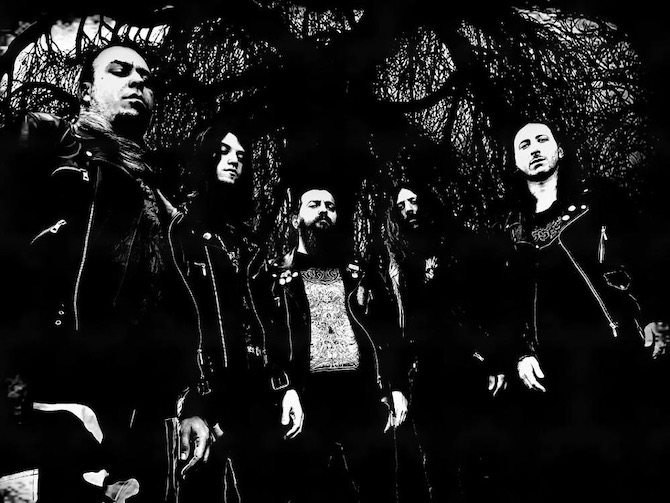
DIABOLIZER
If Decaying Purity is the brutal one and Engulfed is the melodic one, Diabolizer is the fast one. Even though Aberrant handles the skins for Engulfed as well, there’s something about the force of his blastbeats in an album like Khalkedonian Death that adds an extra helping of visceral energy to the ravenous swarm of sound. This group maintains a high velocity with a similar pacing to bands like Angelcorpse and Disavowed, with the riff aesthetic falling somewhere in between those two artists – a very slight blackened edge, but primarily operating in the realm of up-tempo death metal. Krisiun is a good comparison as well, as they arrive at a similar crossroads between old-school and modern. There’s a lot of bands that try and fail at this specific sub-niche, and because it’s so focused and singular it’s difficult to pull off convincingly over a full album.
Diabolizer succeeds, largely in part to that delicious mid tone. The “Apokalypse” EP hinted at it, but it was just a preview of the beautiful, rich guitar sound that graces us on Khalkedonian Death in its fully blossomed form. A few cues are taken from Decaying Purity’s most recent album, purified and concentrated, and then vomited forth with less variety, but more intensity.
Although Diabolizer has the least material of any of the four main bands on this list, they’re the one I’m the most excited for new material from. They bring a fresh and invigorating perspective to a sub-style of metal that desperately needed it, and their debut full-length was actually the catalyst that inspired me to dive into Mustafa’s extensive back catalog back when I covered it for a track premiere here at NCS a handful of months ago. I was astounded by the thorough quality they brought into an otherwise middling subgenre. Usually, I’m skipping multiple tracks at a time, but for Khalkedonian Death I was dialed in all the way through – and then, I realized everything else this riff wizard was involved in was just as consistently good!
Apart from Abomination Demonseed on vocals, every Diabolizer member also plays in Engulfed and Decaying Purity. They also formed after those two bands, in 2012. Would it be fair to call Diabolizer a side project? Why or why not?
From the moment Diabolizer was first founded, it was a formation that I did not want to be keep just as a side project. As I mentioned before, the riffs I wrote for it were much older materials, and when I felt it was the time to use them, we brought Diabolizer to existence.
I sense Angelcorpse is a big influence on Diabolizer’s material. Am I correct? What else influences Diabolizer, compared to how you might approach your songwriting in other projects? The music of this band is generally faster and more focused.
Angelcorpse is a cult band that we all love so much, but I can’t say they are our general inspiration. Diabolizer is a band that contains elements from every style of death metal. Compared to my other bands, it is faster, more aggressive, has a more evil structure, yet you can taste every flavour you would get from traditional death metal. At least, this is what I feel when I listen to the album as a listener.
You worked with Everlasting Spew/Me Saco un Ojo to release Khalkedonian Death, whereas most of your other bands are affiliated with Dark Descent. Is there a reason you didn’t work with Matt (Calvert, DDR label head) to put out Khalkedonian Death?
No particular reason. We got in touch with Everlasting Spew Records through Me Saco Un Ojo Records during the agreement process of the album and they were very interested and set an enthusiastic path for us since the first day we got in touch. Everlasting Spew Records made us a pretty good offer and since it made sense to us, we decided to make a deal with them for CD release, that’s all.
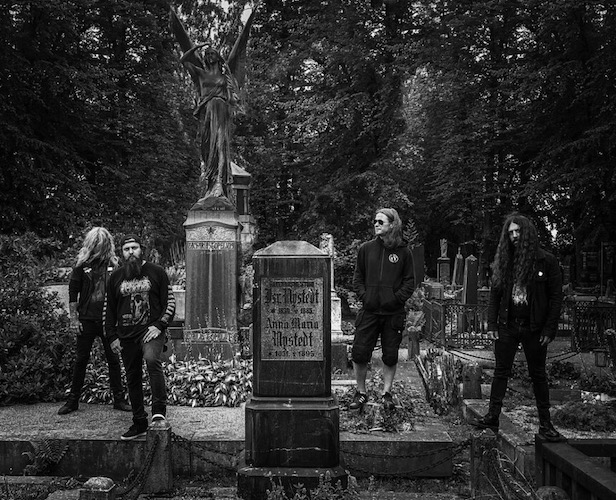
HYPERDONTIA
The cast of characters in Mustafa’s most recent musical undertaking is unusual in that it doesn’t draw from the same half-dozen guys as the other projects in his oeuvre do. Hyperdontia still has one of his most trusted partners in crime, Malik Çamlica, but otherwise this is the only band that outsourced the remainder of their lineup. Drummer Paweł “Tuna” Tunkiewicz (Sulphurous), guitarist Mathias Friborg (Sulphurous), and former vocalist David Mikkelsen (Undergang, Phrenelith) are all Danish in origin.
That gives this group a unique crunch, a regional inflection that isn’t in the other albums I’ve talked about above. They take more cues from more cryptic old-school artists like Demilich and Adremelech, and channel these influences through a pummeling, almost playful riff delivery that I’ve come to describe as the “Danish bounce”. I only seem to hear this same sort of crushing, mercilessly heavy type of fun from bands like Illdisposed, Hatesphere, and even more aggressive and nuanced artists like The Arcane Order and Dawn of Demise have a bit of it. Perhaps everyone there subconsciously takes influence from Volbeat?
Though Hyperdontia technically debuted with a two-song EP in 2017, it was their initial full-length, Nexus of Teeth, that put them on the map. Old-school death metal worship isn’t an uncommon angle these days – if anything, it’s starting to become very over-saturated, but in case you haven’t noticed by now, Mustafa brings an energy and tastiness to his guitar work that elevates the music around it. Careful listens will reveal clear moments where his signature melodic phrasing pops up. It’s menacing, but always with an easy groove to follow, so your head never stops nodding.
The fun in listening to a release like Nexus of Teeth is that I hear more contributions from the other musicians that aren’t in Mustafa’s usual cast of hired guns. David Mikkelsen’s lows are, as usual, so low they almost operate below the frequencies human ears can register, adding a sickly undertone. Tuna’s drum style is choppier and less rolling than Aberrant, not to say he’s any less capable or interesting – his beats just hit you in a different way. Mathias Friborg has a droning, death/doom tinge to his riffs, so if you’ve spent the better part of a few months binging on the musical output of a single artist like I have, you can actually pick out the moments that are Friborg’s ideas and which songs primarily came from Gürcalioğlu.
This brings us to the final and most recent piece in this grand musical puzzle – Hyperdontia’s sophomore album, Hideous Entity. I wanted to have this article ready in time for the November 12 release date of this album, but Mustafa just has too damn many albums that are worth talking about, plus, y’know, life is a thing that happens. At least you have a chance to fully dive into this if you missed it during the initial promo cycle (not to mention the new albums by Diabolizer and Engulfed, as both are less than one year old).
In addition, now that you’ve been given a way-too-thorough introduction to the context that this album came out of, you’ll be able to recognize all the different ways this thoroughly expands on Hyperdontia’s earlier material. You get a few extra playful bass lines, the occasional melodious earworm such as the midway point of “Grinded Teeth”, and chunkier mid-paced grooves. It’s even more apparent that the secret consistency behind Mustafa’s music is that he isn’t afraid to dwell in the middle ground for a while, which creates subtly interesting dips and surges. You can actually focus on it for a full song as opposed to just dialing out until you hear the part you really like, which sometimes happens more often in build-and-release focused song structures.
Minor tweaks and expansions from the debut give you so many new things to enjoy, you don’t even notice that the uber-lows of David Mikkelsen are gone. Guitarist Friborg handled singing duties on this one, having a decent enough growl that they are caked in reverb and buried enough in the mix to get the same general effect. There’s also more going on in the riffs – there’s more than a few nods to Engulfed, so a sparser vocal approach was necessary anyways. Even if the subterranean gurgle is no longer there, so much more has been enhanced it doesn’t even matter.
How did you get into contact with Mathias Friborg and “Tuna” to form Hyperdontia, and what compelled you to form an international band as opposed to finding people to work with in Turkey?
Hyperdontia was an idea that popped up out of nowhere. Some time around the fall of 2015, I sat down and turned some old riffs and parts I had stored and didn’t use into 3 songs. I told Malik to find people so we could make use of these songs. At that time Malik had already moved to Copenhagen. He leaned towards the idea and got in touch with David for vocals and Tuna for the drums. They were both very interested and we decided to give it a go. After recording the first album, Nexus of Teeth, Mathias joined the band.
David Torturdod (Undergang, Phrenelith) provided vocals on Nexus of Teeth, but on Hideous Entity, Mathias pulled double duty and handled all the vocals, marking the only lineup change in the band to date. What prompted this decision?
As I mentioned, the group initially came to life only as a project idea and it was not something we anticipated that we would go this far. David was already busy with his bands Undergang and Phrenelith, and also with his label Extremely Rotten Productions. He had told us from the very beginning that he could only attend the weekend shows. So as things started to move forward and progress, he had to leave the band because he wasn’t able to allocate more time. Mathias, who already was taking over vocals in David’s absence on the live shows, was assigned the role permanently.
Hyperdontia just released a new album, Hideous Entity, on November 12th. Tell me about what’s new on this album, and how things have changed since you released the well-regarded Nexus of Teeth.
I cannot say that there are any radical changes. There are some riffs written by Malik on this album, the only difference might be that as far as the process. Apart from that, there is no fundamental change. We created this beast bringing together death metal materials in the style of our liking and we are very satisfied with the result.
Greg Wilkinson (Autopsy, Brainoil) handled mixing/mastering duties on this. He also worked with Hyperdontia on the “Excreted from the Flesh” EP. What made you interested in him in the first place, and what made you decide to continue working with him?
We like the organic sound of some of Greg’s previous works and we really wanted to work with him. Our communication with him is very good and fast. We put out two excellent intercontinental products together without seeing each other’s faces. We really enjoy what he does.
With both falling into an old-school death metal inspired style, tell me what you think makes Hyperdontia and Engulfed distinct and recognizable in their own ways.
Even though they use similar elements from time to time, the styles of both bands are a little different from each other. In short, I might call one more sinister and the other more barbaric.
—
Wow, you actually made it to the end! Thank you for your interest and time. If you’re looking to support this Turkish riff king, links to buy stuff from Mustafa’s respective labels are below:
SEVARED RECORDS: https://store.sevared.com/search?x=0&y=0&q=decaying+purity
DESSICATED PRODUCTIONS: https://desiccatedproductions.com/shop/collection/hyperdontia/
DARK DESCENT: http://www.darkdescentrecords.com/store/
EVERLASTING SPEW: https://everlastingspew.com/21-everlasting-spew
NIGHT SHIFT MERCH: https://www.nightshiftmerch.com/collections/everlasting-spew-records
ME SACO UN OJO: https://www.mesacounojo.com/
